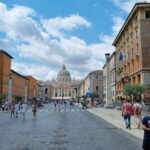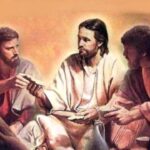Reading time: 5 minutes
Read the story of St. Ignatius of Loyola
Summary
Priest and founder of the “Society of Jesus"(SJ inLatin Societas Jesu)

Birth
Ignazio di Loyola, in spagnolo Íñigo López de Loyola, nasce il 24 dicembre 1491 nel castello di Loyola, nei paesi baschi. È l’ultimo di 13 figli di Beltran Ibañez de Oñaz e di Marina Sanchez de Licona. Ignazio aveva solo sette anni quando morì sua madre.
Dissolute life
Nel 1506, orfano anche di padre, è ad Arévalo, paggio al servizio di un parente, Juan Velázquez de Cuéllar, tesoriere (major counter) of King Ferdinand the Catholic, and, as a courtier, led a debauched lifestyle at that time. Having received a knightly education, in 1517 Ignatius entered the army.
Il 20 maggio 1521,durante l’assedio della fortezza di Pamplona da parte dei Francesi, Ignazio rimane gravemente ferito alle gambe da una palla di cannone e viene ricondotto a Loyola. Durante la lunga degenza, ebbe l’occasione di leggere numerosi testi religiosi dedicati, in particolare, alla vita di Gesù e dei santi. Venne travolto dal desiderio di cambiare la sua vita e trascorrere un’esistenza basata sul proprio lavoro ed ispirata a S. Francesco d’Assisi e ad altre grandi figure spirituali.
Knightly clothes
In 1522 Ignatius went first to Aranzazu (sanctuary near Loyola) and then to Montserrat (not far from Barcelona), to the Benedictine abbey, where he made the general confession of his life. On the eve of the Feast of the Annunciation, he spends the whole night in prayer in a singular "vigil of arms“. He then puts off his knightly clothes and, dressed as a pilgrim, leaves for Manresa (Catalonia), where he leads a life of prayer and penance for more than a year. Ignatius begins writing the Spiritual Exercises (Spiritual exercises). By the Cardoner River"receives great illumination“, from which he emerges profoundly transformed.
Barcelona
In 1523 he arrives in Barcelona, from where he would like to embark for Jerusalem. Instead, he embarks for Gaeta and from here heads for Rome where he meets the Father Adrian VI (Adriaan Florenszoon Boeyens, 1522-1523), who blesses his next pilgrimage to the holy places. From Venice he leaves for the Holy Land. He visits Jerusalem, the Holy Sepulchre, Bethany, Bethlehem, the Jordan, the Mount of Olives, and would like to stop in those places, but must give up his project because the superior of the Franciscans forbids it.
Paris
In 1528 he enrolled at the University of Paris, where he remained for seven years, expanding his literary and theological culture, and trying to interest other students in the Spiritual Exercises.
By 1534 he had six "followers” – Peter Faber (French), Francis Xavier, Alfonso Salmeron, James Lainez, Nicholas Bobadilla (Spanish), and Simao Rodrigues (Portuguese).
On August 15, 1534, Ignatius and the other six students met in Montmartre, near Paris, binding each other with a vow of poverty and chastity and founding the "Società di Gesù“, for the purpose of performing missionary and hospitality work in Jerusalem or going to any place the Pope directed them to.
In 1537 they traveled to Italy seeking papal approval for their religious order. Pope Paul III (Alessandro Farnese, 1534-1549) praised them and allowed them to be ordained priests.
Venice
They were ordained in Venice by the bishop of Arbe (now Rab, in Croatia) on 24 June. They dedicated themselves to prayer and charity work in Italy, also because the new conflict between the emperor, Venice, the Pope and the Ottoman Empire made any trip to Jerusalem impossible.
Rome
With Faber and Lainez, Ignatius went to Rome in October 1538 to have the pope approve the constitution of the new order. A congregation of cardinals proved in favor of the text prepared by Ignatius and Pope Paul III confirmed the order with the papal bull "Regimini militantis ecclesiae” (September 27, 1540), limiting, however, the number of its members to sixty. This limitation was removed through a subsequent bull, the "Iniunctum nobis", of 14 March 1543. The last and definitive approval of theSociety of Jesuswas given in 1550 with the bull "Exposcit debitum” by Pp Julius III (Giovanni Maria Ciocchi Dal Monte, 1550-1555).
Ignatius was chosen as the first Superior General and sent his companions as missionaries around the world to create schools, institutes, colleges and seminaries.
Messina
In 1548, Ignatius founded the first Jesuit College in the world in Messina, the famous "Primum ac Prototypum Collegium" or "Messanense Collegium Prototypum Societatis", and, therefore, the prototype of all the other teaching colleges that the Jesuits will successfully found in the world by making teaching the distinctive mark of the order.
The rule of Ignatius became the unofficial motto of the Jesuits: "Ad Maiorem Dei Gloriam”. Tra il 1553 ed il 1555, Ignazio dettò al suo segretario, padre Gonçalves da Câmara, la storia della sua vita. Questa autobiografia, essenziale per la comprensione dei suoi Spiritual Exercises, however, remained secret for over 150 years in the archives of the order, until the text was published in the "Acta Sanctorum".
Rimasto a Roma per volere del papa, Ignazio coordinava l’attività dell’Ordine, nonostante soffrisse dolori lancinanti allo stomaco, dovuti ad una calcolosi biliare e ad una cirrosi epatica mal curate; limitava a quattro ore il sonno per adempiere a tutti i suoi impegni e per dedicarsi alla preghiera e alla celebrazione della Messa. Il male fu progressivo limitandolo man mano nelle attività, finché il 31 luglio 1556, il soldato di Cristo, muore in una modestissima camera della Casa situata vicina alla Cappella di Santa Maria della Strada a Roma.
Beatification
He was beatified on July 27, 1609 by Pp Paul V (Camillo Borghese, 1605-1621)and proclaimed a saint on March 12, 1622 by Pp Gregorio XV (Alessandro Ludovisi, 1621-1623).
Il 23 luglio 1637 il suo corpo fu collocato in un’urna di bronzo dorato, nella Cappella di sant’Ignazio della Chiesa del Gesù in Rome. The statue of the Saint, in silver, is the work of Pierre Legros.
The religious feast is celebrated on July 31, the day of his "dies natalis".
Meaning of the name Ignatius: «of fire, igneous» (Latin).
For further information on the history of the saint and his spiritual exercises click here

(source © gospeloftheday.org)





